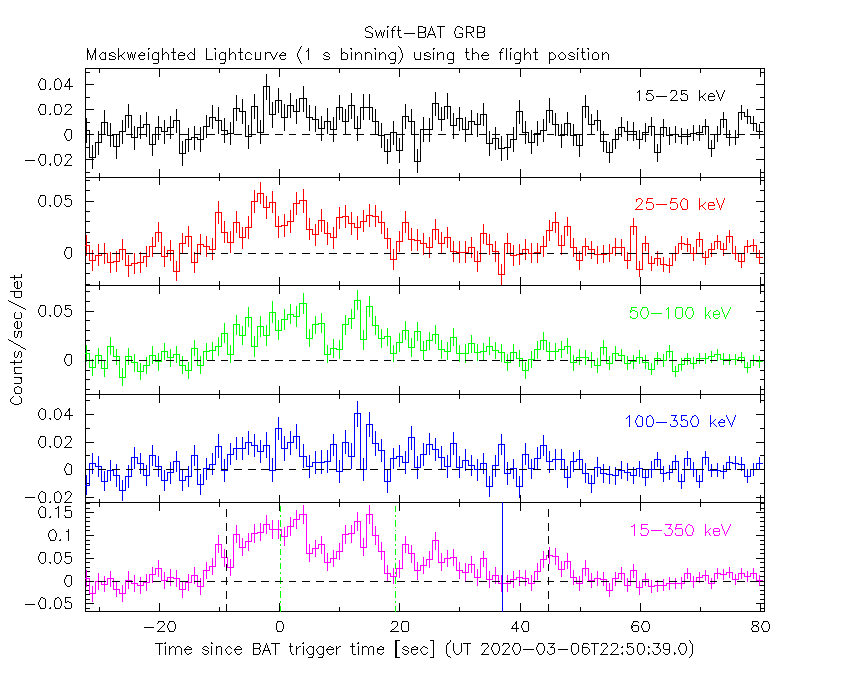
J.D. Gropp (PSU) and K.L. Page (U. Leicester) for the Swift team
At 22:50:39 UT, the Swift Burst Alert Telescope (BAT) triggered and located GRB 200306C (trigger=960102) (Gropp et al. GCN Circ. 27326). Swift slewed immediately to the burst. At the time of the trigger, the initial BAT position was 149° from the Sun (9.9 hours West) and 65° from the 89%-illuminated Moon. Table 1 contains the best reported positions from Swift, and the latest XRT position can be viewed at http://www.swift.ac.uk/xrt_positions.
Gropp et al. (GCN Circ. 27326) reported the discovery with UVOT of an optical afterglow. Table 2 is a summary of GCN Circulars about this GRB from observatories other than Swift.
Standard analysis products for this burst are available at https://gcn.gsfc.nasa.gov/swift_gnd_ana.html.
As reported by Stamatikos et al. (GCN Circ. 27353),
the BAT ground-calculated position is RA, Dec = 198.577, 11.263 deg which is RA(J2000) = 1
The mask-weighted light curve (Figure 1) shows several overlapping pulses that start at ~T-12 s and end at ~T+50 s.
The time-averaged spectrum from T-12.33 to T+50.70 s is best fit by a simple power-law model.
The power law index of the time-averaged spectrum is 0.83 ± 0.12.
The fluence in the 15-150 keV band is 2.8 ± 0.2 x 1
The results of the batgrbproduct analysis are available at https://gcn.gsfc.nasa.gov/notices_s/960102/BA/.
Analysis of the initial XRT data was reported by Page et al. (GCN Circ. 27345). We have analysed 19 ks of XRT data for GRB 200306C, from 101 s to 258.0 ks after the BAT trigger. The data comprise 36 s in Windowed Timing (WT) mode (the first 9 s were taken while Swift was slewing) with the remainder in Photon Counting (PC) mode. The enhanced XRT position for this burst was given by Osborne et al. (GCN Circ. 27342).
The late-time light curve (Figure 2) (from T0+5.5 ks) can be modelled with a power-law decay with a decay index of α=2.61 (+0.24, -0.20).
A spectrum formed from the PC mode data can be fitted with an absorbed power-law with a photon spectral index of 1.56 (+0.11, -0.10). The best-fitting absorption column is 4.2 (+3.1, -2.3) x 1
A summary of the PC-mode spectrum is thus:
Total column: 4.2 (+3.1, -2.3) x 1
Galactic foreground: 1.9 x 1
Excess significance: <1.6 σ
Photon index: 1.56 (+0.11, -0.10)
The results of the XRT team automatic analysis are available at http://www.swift.ac.uk/xrt_products/00960102.
The Swift/UVOT began settled observations of the field of GRB 200306C 118 s after the BAT trigger
(Gropp GCN Circ. 27352).
Table 3 gives preliminary
magnitudes using the UVOT photometric system
(Breeveld et al. 2011, AIP Conf. Proc., 1358, 373).
No correction has been made for the expected extinction in the Milky Way
corresponding to a reddening of

Figure 1. The BAT
mask-weighted light curve in the four individual and total
energy bands. The units are counts

Figure 2. The XRT light curve.
Any data from a crosshatched region are not included in the fit.
| RA (J2000) | Dec (J2000) | Error | Note | Reference |
|---|---|---|---|---|
| 1 |
+11°16'11.7" | 0.43" | UVOT-refined | Gropp GCN Circ. 27352 |
| 1 |
+11°16'13.0" | 1.6" | XRT-final | UKSSDC |
| 1 |
+11°16'10.3" | 2.2" | XRT-enhanced | Osborne et al. GCN Circ. 27342 |
| 1 |
+11°15'47.7" | 1.3' | BAT-refined | Stamatikos et al. GCN Circ. 27353 |
| Band | Authors | GCN Circ. | Subject | Observatory | Notes |
|---|---|---|---|---|---|
| Optical | Jelinek et al. | 27328 | FRAM-ORM afterglow detection | FRAM | detection |
| Optical | Hu et al. | 27329 | BOOTES-1 detection of the optical afterglow |
BOOTES-1 | detection |
| Optical | Ackley et al. | 27332 | GOTO upper limits | Gravitational-wave Optical Transient Observer | upper limits |
| Optical | Moskvitin | 27333 | SAO RAS observations of OT | SAO RAS | detection |
| Optical | Izzo and Perley | 27334 | Liverpool Telescope observations | Liverpool Telescope | detection |
| Optical | Kann et al. | 27335 | OSN 1.5m afterglow detection | Obs.de Sierra Nevada | detection |
| Optical | Strausbaugh and Cucchiara | 27337 | LCO Optical Upper Limits | LCO | upper limits |
| Optical | Steele | 27338 | First Hour Liverpool Telescope Observations |
Liverpool Telescope | detection |
| Optical | Lim et al. | 27339 | KCT upper limit of the optical afterglow | upper limits | |
| Optical | Gokuldass et al. | 27341 | VIRT optical upper limits | Virgin Island Robotic Telescope | upper limits |
| Optical | Kann et al. | 27348 | Calar Alto 2.2m upper limit | Calar Alto | upper limits |
| Radio | Laskar et al. | 27354 | ALMA 3mm upper limit | ALMA | upper limits |
| Filter | Exp(s) | Mag | ||
|---|---|---|---|---|
| u_fc | 141 | 390 | 245 | |
| u | 899 | 1049 | 147 |
Table 3. UVOT observations reported by Gropp (GCN Circ. 27352). The start and stop times of the exposures are given in seconds since the BAT trigger. The preliminary detections and 3-σ upper limits are given. No correction has been made for extinction in the Milky Way.
March 10, 2020